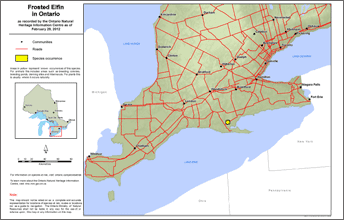Frosted elfin
Scientific name: Callophrys irus

Cover photo credit: J.D. Taylor
Status
Extirpated
“ Extirpated ” means the species lives somewhere in the world, and at one time lived in the wild in Ontario, but no longer lives in the wild in Ontario.
Date added to the Species at Risk in Ontario List
The Frosted Elfin was listed as endangered when the Endangered Species Act took effect in 2008, and was re-classified as extirpated on September 10, 2009.
Read the most recent assessment report (PDF)
What it looks like
The Frosted Elfin butterfly gets its name from the pale gray scales that edge its hind wings and give them a frosted look. The male has gray-brown upper wings and the female’s are reddish brown. This tiny butterfly has a wingspan of about 2.5 centimetres. The caterpillars are a light blue-green and have white lines down the back.
Where it lives
The Frosted Elfin butterfly is found predominately in oak savannah and pine barren habitats, as well as open woods and forest edges where wild blue lupine, the sole food plant of the butterfly larvae, grows.
Females lay eggs on the flower buds of wild lupine, and the caterpillars feed on the flowers and seedpods. In late summer, the caterpillars build a shelter in the leaf litter on the ground by tying leaves together with silk, and they overwinter in the pupal stage. In early spring, the adult butterflies emerge.
Where it’s been found in Ontario
The only known Canadian site for this species was in an area of oak savannah near the St. Williams Forestry station in Norfolk County in southern Ontario. It was last recorded there in 1988.
The range of the Frosted Elfin extends from New England west to Minnesota , and south to Alabama.
View a Larger version of this map (PDF)
Why it disappeared from Ontario
The Frosted Elfin was likely never common or widespread in Ontario. It was only discovered here in 1960 and has only been confirmed at one location. Its demise was due to its dependence on the lupine plant for survival. Natural succession and the planting of pines in the 1940s at the site eventually created shady conditions that lupines could not tolerate. As the lupines disappeared, so did the Frosted Elfin.
Throughout its eastern North American range, the Frosted Elfin butterfly has declined largely as a result of habitat loss. Its preferred oak savannah habitat is one of the most threatened habitats in eastern North America today.
Action we are taking
Extirpated species and their habitat are protected if the species are again found in Ontario.
Help make sure we don’t lose more endangered species in Ontario
- The Ministry of Natural Resources and Forestry tracks species at risk such as the Frosted Elfin. You can use a handy online form to report your sightings to the Natural Heritage Information Centre. Photographs with specific locations or mapping coordinates are always helpful.
- Report any illegal activity related to plants and wildlife to
1-877-TIP-SMNR (847-7667) . - Private land owners have an important role to play in species recovery. You may be eligible for stewardship programs that support the protection and recovery of species at risk and their habitats.
- Volunteer with a local nature club or provincial park to participate in surveys or stewardship work focused on species at risk.
Quick facts
- The Frosted Elfin is a poor flier, which, along with its dependence on lupine, may explain why its populations are isolated and scattered.
- Males are territorial and will defend their home stands of wild lupine.
- The Frosted Elfin shares the same foodplant as other extirpated butterfly species in Ontario, the Karner Blue and Eastern Persius Duskywing.
